India
In 1837 the 3rd Dragoons set sail for India, brought up to the strength of 420 men, of whom only 47 would return to England in 1853.
For four years the 3rd Dragoons had no enemy except the intense heat; then in the January of 1842, they set out to avenge the complete slaughter of the British garrison in Kabul, butchered on their attempted return to India.
Cabool 16 September 1842
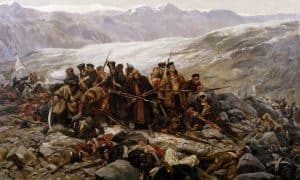
The Retreat from Cabool 1842
The 3rd Dragoons were involved in this punitive expedition to relieve the Fortress of Jalalabad and release the prisoners from Kabul. This all resulted from the British puppet, placed on the throne in 1839, massacring the British Mission in Kabul from which only one survivor made it to Jalalabad. It was a bitterly hard march through the Kyber Pass to the besieged garrison, involving fighting against tribesmen all the way.
Having reached and secured Jalalabad, the Army was then ordered to “withdraw by the way of Kabul” in order to punish the Afghans. The advance on Kabul involved a series of battles, at one of which Akbar Khan sent a division to attack the Rearguard containing the 3rd Dragoons.
They had 2000 horsemen but three of our squadrons charged them so fiercely that they dispersed the cavalry and then went on to put their infantry to flight.
In the final confrontation outside Kabul, “the 3rd Dragoons actively engaged in cutting up and dispersing several portions of the enemy“.
Having recaptured Kabul, it was decided by the Governor-General to abandon Afghanistan; thus the 3rd Dragoons moved back to India. It was the turn of the Sikh Army to suffer in 1845 as they crossed into India with 60,000 men on 11 December.
Within sixty-two days the Sikh Army had been utterly defeated in four major battles, known as the Sikh Wars. The first of these was Moodkee, at which the 3rd Dragoons and the second Brigade of Cavalry were present.
Moodkee 18 December 1845
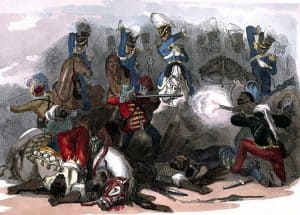
Battle of Moodkee 1845
The 3rd Dragoons played a momentous role in the first battle of the Sikh Wars, earning the nicknames “Moodkee Wallahs” and “The Devil’s Children” from the Sikhs.
Early in the day on the 18th the British “Army of the Sutlej” advanced on Moodkee and finding that Lal Singh had withdrawn they made camp, only to be alerted to an imminent Sikh attack a few hours later.
The 3rd Dragoons were ordered to attack the enemy’s left flank and were loudly cheered as they set off on their charge. They turned the left flank and then swept along the whole rear of the Sikh lines, cutting down infantry and artillery and causing great confusion.
On the return journey, they found themselves facing a body of 3000 cavalry and, it charging it, put them all to fight.
The Dragoons lost 61 killed and 35 wounded, but could only rest for three days before being put into battle again, charging the Sikh guns at Ferozeshah.
Ferozeshah 21 December 1845
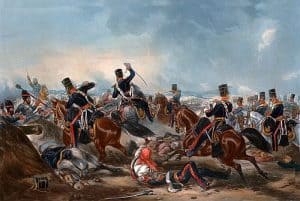
Battle of Ferozeshah December 1845
The 3rd Dragoons played a magnificent part in this battle against the invading Sikh Army. The Sikhs were in an entrenched position at Ferozeshah and to begin with, the 3rd Dragoons moved up slowly in support of the infantry, but at the crucial moment when the centre two divisions had gained a tenuous foothold on the enemy fortifications, the 3rd was launched in a charge against their left flank.
They went headlong over the entrenchments cutting down the gunners then, shouting wildly, they stormed through the camp, leaping over guy ropes, tent pegs, guns and every sort of obstacle until they smashed straight through the Sikh reserves coming out of the other side of their position, where they rallied.
The next day a second Sikh Army of 20,000 men approached, when all the Anglo-Indian cavalry, through a staff mix-up, departed for Ferozepore leaving the 3rd as the only cavalry with the Army.
The massed Sikh cavalry charged our lines but inexplicably halted 150 meter’s away and then allowed the 3rd to charge and repulse them. They turned about and fled, followed by all their infantry and gunners who abandoned all their equipment.
In the two days the Dragoons had lost 55 killed (including 2 officers) and 100 wounded.
The final battle in which the 3rd Dragoons fought in the First Sikh War was at Sobraon.
Sobraon 10 February 1846
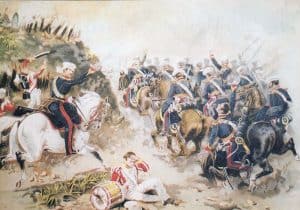
Battle of Sobraon 1846
The 3rd Dragoons showed great discipline and control in this final battle of the 1st Sikh War.
The Sikh Army had occupied a position straddling the River Sutlej, with their heavy artillery and reserves on the northern bank and their main force holding a fortified bridgehead on the southern bank around the village of Chota Sobraon.
The infantry attacked and managed to push the enemy back far enough to allow our sappers to blow a gap in their redoubt on the left flank. The cavalry was then led through the breach in single file, were formed up in a perfect line and then charged through the massed defenders, putting them to flight.
The Sikhs were forced to flee back over the river and when there were about twenty thousand on the bridge it collapsed, allowing the British to fire at will into the struggling mass.
Chillianwallah 13 January 1849
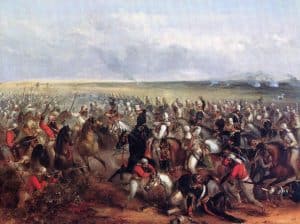
The Battle of Chillianwallah’ 13 January 1849.
Three years later the Sikhs mutinied again, and as before the 3rd were included in the force sent against them for the Second Sikh War.
The Battle was first joined by the rival armies at Chillianwallah, a defeat for the British.
The 3rd Dragoons did, however, see glory.
Captain Unett’s Squadron cut a path half a mile deep in the enemy, leaving 24 dead and 20 wounded on the field of battle.
Unfortunately, as the Allies lost 700 dead and twice that wounded, this battle was seen as a miserable defeat by the Government.
It was only a month before the final battle in the war, which routed the Sikhs at Goojerat.
Goojerat 21 February 1849
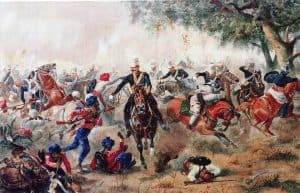
Battle of Goojerat 1849
The 3rd Dragoons were at the Battle of Goojerat, but one of their own officers rightly accorded the lion’s share of the victory to the massive numerical superiority of artillery.
The battle began as an artillery slogging match that went on for about three hours before a sufficient number of the enemy guns had been knocked out to allow a general advance.
At this the Sikhs eventually threw down their arms and fled, being chased for twelve miles by the cavalry.
The 3rd Dragoons suffered one trooper wounded.
This was the final battle in India for the 3rd Dragoons who returned to England showered with praise by the Indian hierarchy, in 1853.
Campaign Medal
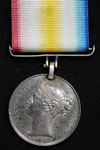 The Candahar, Ghuznee, Cabul Medal was awarded to those who took part in the campaign in the spring and summer of 1842, under the command of General William Nott, to restore British standing in Afghanistan after earlier defeats during the First Anglo-Afghan War.
The Candahar, Ghuznee, Cabul Medal was awarded to those who took part in the campaign in the spring and summer of 1842, under the command of General William Nott, to restore British standing in Afghanistan after earlier defeats during the First Anglo-Afghan War.

